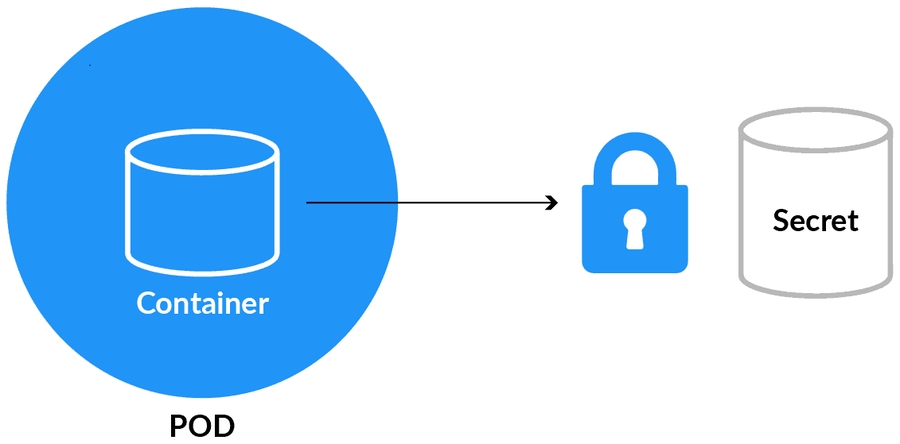Kubernetes ConfigMap and Secret
Kubernetes Configmaps
If we have many object files, it won’t be easy to manage the environment data stored within the query files. We can take this information out of the pod definition file and execute it centrally using Configuration Maps. ConfigMaps are used to provide configuration data in key-value pairs in K8s. There are two phases involved in configuring ConfigMaps. The first is to create the ConfigMaps, and the second to inject them into the pod.

ConfigMaps
There are two ways of creating a config map:
i) The imperative way – without using a ConfigMap definition file ii) Declarative way by using a Configmap definition file.
Create a ConfigMap
ConfigMap can be written manually as a YAML representation and load it into Kubernetes, or you can also apply the kubectl create configmap command to create it from the CLI.
Create a ConfigMap Using kubectl
Run the kubectl create configmap cmd to create ConfigMaps from directories, files, or literal values:
Where <map-name> is the name you want for ConfigMap and <data-source> is the directory, file, or literal value to draw the data from.
Check Out: How to launch Kubernetes dashboard. Click here
ConfigMaps and Pods
You can write a Pod spec that attributes to a ConfigMap and configures the container based on the data in the ConfigMap. Note that the Pod and the ConfigMap must exist in the same namespace.
Let’s look at an instance now, ConfigMap, with some keys with single values and other keys where the value looks like a fragment of a configuration format.
There are four various ways you can use a ConfigMap to configure a container in a Pod:
Entrypoint of the containers via command line.
Environment variables for a container.
Also, we can add a file in read-only volume for the application to read.
Manually written Code to run inside the Pod that uses the K8s API to read a ConfigMap.
Also Read: Our previous blog post on Kubernetes deployment. Click here
Using ConfigMaps
ConfigMaps can be mounted as data volumes. Other parts of the system can also use ConfigMaps without being directly exposed to the Pod. For example, ConfigMaps can hold data that different system parts should use for configuration. The usual way of using ConfigMaps is to configure environments for containers running in a Pod in the same namespace. You can also use ConfigMap separately.
Check Out: Kubernetes Operator Example. Click here
Immutable ConfigMaps
The K8s beta feature Immutable Secrets and ConfigMaps gives an option to set specific Secrets and ConfigMaps as immutable. And for clusters that extensively use ConfigMaps, restricting modifications to their data has the following advantages:
Protects you from accidental updates that could cause applications outages
Improves the performance of your cluster by significantly reducing the load on the Kube-API server by closing watches for ConfigMaps marked as immutable.
The Immutable Ephemeral Volumes control this feature gate. You can build an immutable ConfigMap by fixing the immutable field to true. For example:
Also Read: Our blog post on Docker and Kubernetes. Click here
Kubernetes Secrets

Kubernetes Secrets
Secrets 🔐 are used to hold sensitive data like passwords or keys. They’re similar to configMap except that they’re stored in an encoded or hashed format with config maps.
There are two levels involved in working with secrets. First, to create the secret, and second, to introduce it into the pod. Putting confidential data in secret is safer and adaptable rather than putting it in a container image or a Pod definition.
To use a secret, a pod has to reference the secret. There are three ways to use a secret with a Pod:
As a file in a volume mounted on one or more of its containers.
As a container environment variable.
kubelet uses secrets by pulling images for the Pod.
Built-in Secrets
Built-in Secrets is where Service accounts automatically create and Attach Secrets with API credentials. K8s automatically creates secrets that include credentials for reaching the API and automatically alters your pods to use this type of secret. The automatic and also the use of API credentials can be overridden or disabled if wanted.
Creating a Secret
There are several options to create a Secret:
Create Secret using kubectl command
We can create a Secret from the config file
Create Secret using customise
Editing a Secret
Run the following command to edit a Secret:
Using Secrets
Secrets can be attached as data volumes or exhibited as environment variables used by a container in a Pod. Other parts of the system can also use secrets without being directly exposed to the Pod.
Also Read: Our previous blog post on Kubernetes labels. Click here
Updating Secrets and ConfigMaps

Kubernetes manages our environment variables, which means we don’t have to change code or rebuild containers when changing the variable’s value. The updation is a two-step process because pods cache the value of environment variables during startup.
First, update the values:
Then, restart the pods. This can be done in various ways, such as forcing a new deployment. The quick and easy way is to delete the pods manually and have the deployment automatically spin up new ones.
It is most suitable to create your Secrets and ConfigMaps using the above method so kubectl can record its annotation for tracking changes to the resource in the spec. Another way of doing this is using the –save-config command-line option when running kubectl create secret|configmap.
Last updated
Was this helpful?